Interview with cinematographer Aurélien Marra about "Two of Us", by Filippo Meneghetti
Nina and Madeleine are deeply in love with one another. To others, they’re nothing but neighbors living on the top floor of their building. Every day, they go back and forth between one another’s apartments and share their lives together. No one really knows them, not even Anne, Madeleine’s caring daughter. Until the day a tragic event causes everything to change…
What was the origin of this project ?
Aurélien Marra : I met Filippo Meneghetti in 2016, while he was shooting his first French short film, La Bête. A nearly silent film, set in a fantasy Brittany in the 19th century. Very different from Two of Us ! Because things went really well between us on the short, I naturally wanted to work with him on his feature film project he’d already discussed with me while we were filming La Bête. At that time, I hadn’t yet worked on a feature film and I couldn’t really imagine I’d be approved by the producers for that project. Especially since the film was a French, Belgian and Luxembourgish co-production with strict controls on spending in the co-producer countries, particularly in terms of salary. But in the end, mostly because of the success of the short film (selected in many festivals in 2017 and 2018), all of the partners trusted in me…
How did you prepare for the film ?
AM : I had long discussions with Filippo, which started about three months before shooting did. When it was still just a screenplay, the film was written in a classic drama format. I think that he wanted his dramatic intentions to be understood by the various financing bodies. But this isn’t exactly the way the finished film turned out ; it got much more ambiguous. During preparation, Filippo explained to me how much he wanted to distill a certain irony, and sometimes even true suspense, in order to distance himself from the classical drama format. The term “thrilling” was often repeated. These discussions and inspiration from other films allowed us to obtain this result.
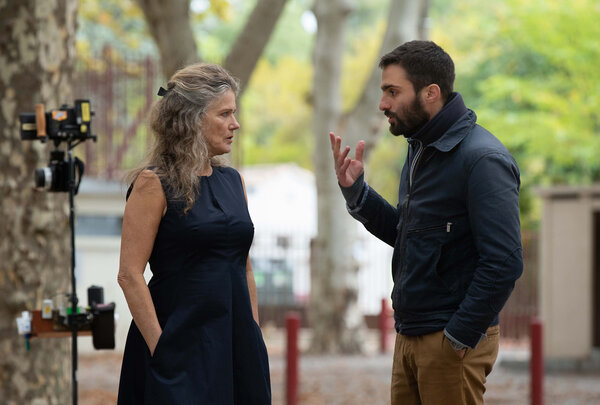
Which films ?
AM : For example, Francis Ford Coppola’s The Conversation (cinematography by Bill Butler). I remember the first scene where Gene Hackman is entering his apartment. When you analyze the scene, you realize it’s made of a series of panoramic shots that are totally out of sync with the characters’ movements… The camera sometimes continues its movement while the actor has stopped somewhere. That type of grammatical motif was extremely important for Filippo, in the idea of making the camera somewhat independent from the characters. To create a sort of feeling of discordance…
I can also cite A Special Day, by Ettore Scola (cinematography by Pasqualino De Santis). There, too, the camera is somewhat independent from the scenography, but in a melancholier tone. In a certain way, this is the same technique as in The Conversation, but applied to a different emotion.
Another important film was Jonathan Glazer’s Birth (cinematography by Harris Savides), where the slow frontal zoom shots without reframing inspired us for how to convey the characters’ introspective moments. In any case, that’s how Jonathan Glazer uses it, even though on Two of Us, we opted for a wider zoom shot, and ended up maybe with a bit more baroque effect.
Lastly, but more generally, there is Bong Joon-ho with Mother (cinematography by Hong Kyung-pyo) and Memories of Murder (cinematography by Kim Hyung-koo), where the editing choices seemed us to constantly put drama and absurdity on an equal footing in the narration…
An example of a scene in the film ?
AM : I’m thinking about the moment where Nina (Barbara Sukowa) enters Mado’s apartment at night… As she leans over to whisper in her ear to ask for forgiveness in a medium shot, you first hear, and then see, the half-asleep home nurse go into the kitchen to pour herself a glass of water. A situation that is both dramatically tense and almost farcical, at the very limit of the implausible. And this takes place in an establishing shot, moreover ! That means there’s no margin for adjustment. And that’s the kind of scene, during shooting, where we’d wonder “will it work ?” I feel it’s in moments such as these that we were able to create something different from pure drama.
Did you hesitate to film that scene ?
AM : No, I mean that situation was actually described in the screenplay… But it came down to a question of dosing. For example, we could have hid Nina better… And especially why does the night nurse stop smack in the middle of the background to drink her glass ? For it to work, we had to totally go with the absurdity of the moment.
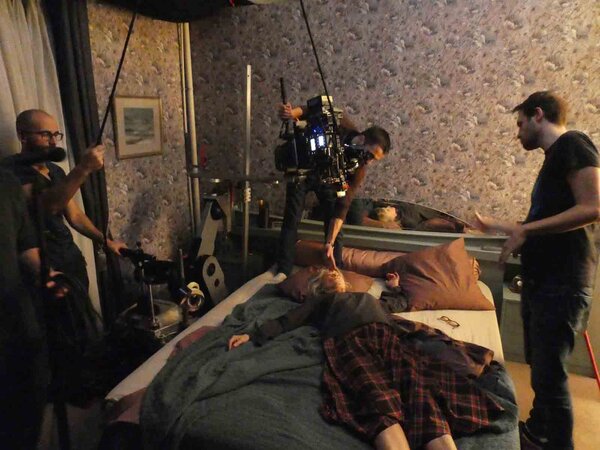
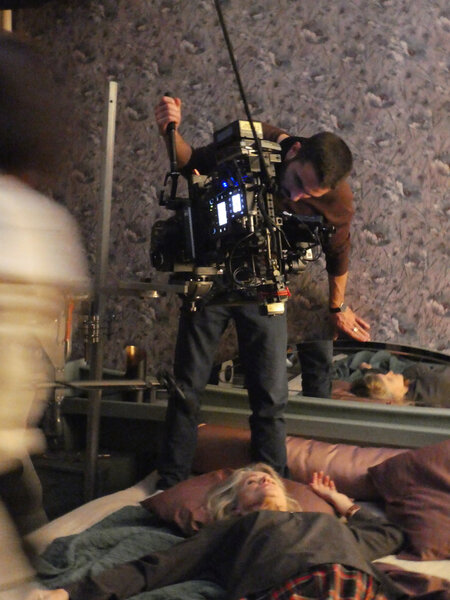
[Aurélien Marra and Barbara Sukowa]
Let’s discuss the part shot in studio… Uncommon for a first French film !
AM : The Luxembourgish coproduction led us to that decision. It’s true that at first, Filippo was pretty worried. It feels safer, especially on your first film, to rely on reality rather than to have to recreate it from A to Z. I did everything I could to convince him to let go of that idea, particularly by explaining to him that we could absolutely take a similar approach to a studio set as we would on location. But, the requirement of the studio was something that weighed heavily on the film’s budget (€2 million), forcing us to cut costs elsewhere. Of course, once we’d made the decision, we took the situation in hand and we tried to make the best of it with our art director Laurie Colson (art director on Grave). One of the main advantages was that we were able to design the layout of the rooms in the apartments to match the director’s intentions. Unlike the very first models, we swapped the kitchen and the bedroom in order to create stronger perspectives between both apartments. This type of decision was able to be taken directly, thanks to the work on editing and by 3D projections on the set. The studio also allowed us to push our set design to very precise levels in order to customize both apartments. This was a really fun and really enriching job, even though we had very strict budgetary constraints.
What is an example of the type of cost-cutting you had to do ?
AM : We had to give up on the idea of looking out of windows. The price of a good-quality photographic background for the window was simply out of budget, without mentioning the green screen for a set that occupies 80% of the film : we would have had to composite one out of every three shots. I had to restrict myself to overexposed windows by using fabric to maintain a feeling of materiality in the windows. It was a bit heartbreaking for me, since I’m not a great lover of this type of photographic situation, but it really allowed us a great deal of financial leeway for the set design. We were able to enjoy the comfort of shooting in studio, but with every decision we made, we had to weigh the pros and the cons from the producers’ perspective.
In what order did you shoot ?
AM : Shooting began with the outdoor shots in the south of France in late September 2018. Even though it was hard to begin with shooting peripheral scenes, it helped me to obtain precise knowledge of the types of outdoor light environments I was going to have to match with the studio scenes. Another important detail : the studio apartment was directly inspired by the real apartment that we used for the few outdoor street and balcony shots. I also entirely designed my prelight for the studio set using this apartment’s real environment as a reference and basing it on a multitude of light readings and the angle at which light entered the actual apartment. In a way, the studio lighting is directly calibrated on the actual light in that apartment, with, of course, a few adjustments…
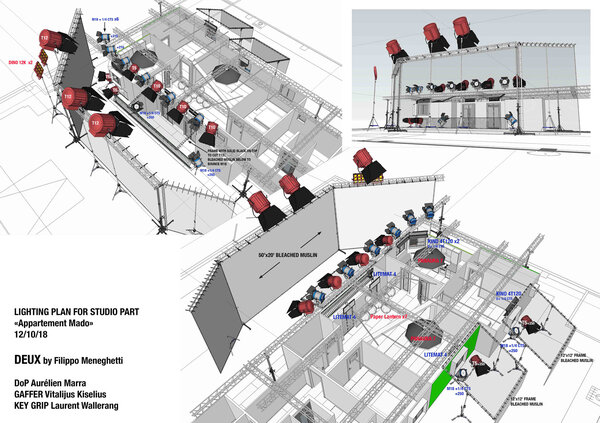
What was your lighting strategy ?
AM : I had noticed, for example, that the real apartment was often lit by the sun bouncing off of the neighboring façade. In order to recreate a well-structured base from these observations, and, in particular, to reproduce the colorimetric mix of warm light coming from the building across the way, and the cooler light coming from the sky, I decided to use a very large area of white cotton (15m x 6m) and to light all of its lower half using tungsten lamps and the upper portion using daylight, in order to create a very large and soft two-color source, which was diffused again by the curtains at the windows. Since the living room set had two French windows opening onto a balcony, and the kitchen had two windows, I had a large palette of light angles I could apply to the actors. My double-colorimetry prelight, besides giving complex and realistic texture to the light entering the windows, allowed me to quickly change the outdoor light ambience while maintaining exact control over the indoor light balances, especially with the prop lights, which could only be adjusted within a narrow range.
Let’s talk about the night meal at Madeleine’s daughter, Anne’s…
AM : That scene in Anne’s house (Léa Drucker) was shot in northern France on location, a few kilometers from the border with Luxembourg. It wasn’t easy to match it with the southern architecture, which is why we tried not to show the area around it too much. For the long take master shot where the characters are shown in reflection in the window, our camera set-up was very constraining, and we had very limited means for lighting and it was absolutely necessary that the camera not be seen, despite its being placed directly facing the window. Moreover, the stone thrown through the window, which ends the scene, had to be done on set, with all of the difficulties in terms of security that you might imagine. Trials had been done beforehand with the set design team, and the glass broke easily and harmlessly. However, when the glass was set within the actual French window, the housing consolidated it and it became quite resistant…nearly unbreakable, in fact ! In order to have any hope of breaking the glass, the stone had to be thrown with a great deal of force and that made things a bit dangerous ! So, we decided to fall back on a two-step compositing. On the first step, the actors finished the scene and feigned a reaction to the glass which was supposed to be breaking, and on the second step, we actually broke the glass after having removed the actors. We needed two or three throws to finally make it break ! In the end, that enabled us to precisely adjust the timing in order to synchronize it all and obtain an ideal broken glass effect.
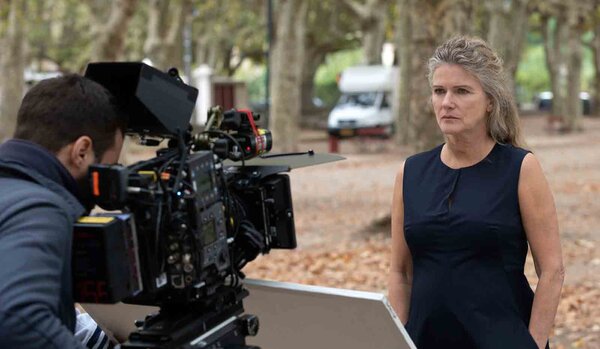
Did you do any tests with the camera equipment ?
AM : Filippo has a very developed knowledge of photography, and if he hadn’t chosen to be a director, I think he’d make an excellent cameraman ! He was very involved in the technical preparation of the film, especially regarding the choice of tools. The two of us did do comparative tests together at Lites, our Belgian supplier. As concerns the camera, we chose to shoot with a Sony Venice, in RAW 4K (Super 35), with pretty old lenses, the Bausch & Lomb Super Baltars. I like this series because it has a very distinct rendering, which is very soft at full aperture but becomes much more contrasted and sharper when you close the aperture a bit.
Of course, all lenses react that way, but the Super Baltars do it with a very large amplitude of difference. That gives you a creative margin that I really like, since it’s almost like having two different series of lenses. We got a lot of use out of the 25mm, a lens with a very straight geometry, which is pretty surprising for the technology of the period. The only negative was that those lenses aren’t very consistent from focal length to focal length, and I had to perform a pretty intensive series of tests to find the right combination of diffusion filters and differential in color temperature in order to match the lenses with one another. In terms of visualizing the image on set, I had a very highly contrasted LUT, which was pretty unforgiving ! This technique made me be very precise in the moment and prevented me from doing too much salvaging during color grading. I think that one’s intention must be expressed as radically as possible during production, and color timing is only there to affirm that intention… In any case, it’s never there to amend it.
(Interview by François Reumont on behalf of the AFC, translated from French by A. Baron-Raiffe)
Two of Us
Directed by Filippo Meneghetti
Screenplay by Filippo Meneghetti and Malysone Bovorasmy
Set Design by Laurie Colson
Original Soundtrack by Michele Menini
Editing by Ronan Tronchot
Production Director : Vincent Canart
First Assistant Director : Brice Morin
(The thumbnail image at the beginning of this article is of Barbara Sukowa and Martine Chevallier in Two of Us)
 En
En Fr
Fr




